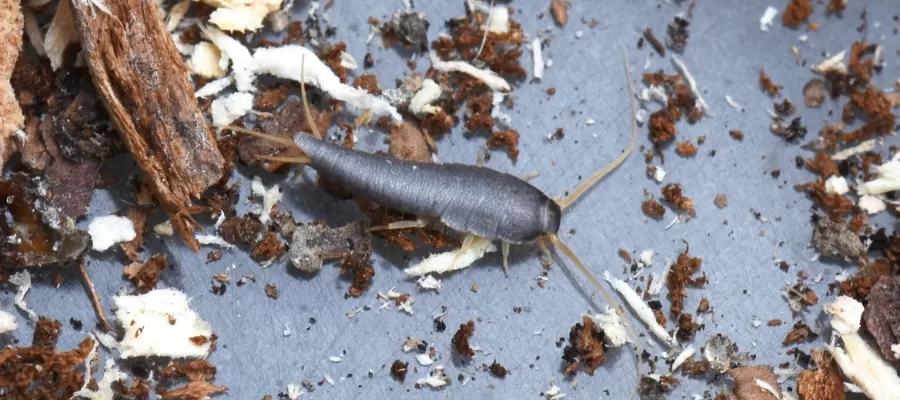You’ve spotted tiny, quick-moving bugs darting across your bathroom floor or hanging around the baseboards in your kitchen. They’re too small to swat, and every time you think they’re gone, they’re back.
Most homeowners assume it’s just one type of pest, but in reality, it’s often a battle between two lookalikes: silverfish and springtails. Telling the difference matters because each requires a different treatment approach. If you’ve found yourself searching for the difference between silverfish vs springtail, you’re already ahead of the game.
At Wipe Out Pest Control, we specialize in fast, accurate pest identification and safe, effective treatments that actually solve the problem without contracts or guesswork.
Silverfish vs Springtail: The Key Differences
When tiny bugs start showing up in your home, knowing what you’re dealing with is the first step to getting rid of them for good. Silverfish and springtails may seem similar at first glance, but they behave, and thrive, very differently. Here’s how to tell them apart:
| Feature | Silverfish | Springtail |
| Appearance | Teardrop-shaped body, ½ inch long, silver-gray, moves in a wiggling motion. Long antennae and three tail-like bristles. | Tiny (1–2 mm), rounder body, dark gray to black. Moves in quick, erratic jumps when disturbed. |
| Movement | Crawls fast in a fish-like motion | Jumps when startled (using a spring-like tail) |
| Habitat | Prefers warm, dry spaces—attics, closets, bookshelves. Feeds on paper, glue, and dead skin. | Found in moist areas—bathrooms, basements, sink drains, potted plants. Feeds on fungi and organic matter |
| Behavior | Nocturnal, avoids light, active year-round | Active in high humidity, often found in clusters, thrives in wet conditions |
| Attracted to | Starch, paper, wallpaper glue, dry goods | Moisture, mold, damp soil or wood |
Importance
Treating silverfish requires reducing paper and food-based attractants and sealing dry entry points. Springtails, on the other hand, often signal a moisture problem. Treating them means fixing leaks and lowering humidity.
At Wipe Out Pest Control, we identify and address the exact pest and its root cause. So, it doesn’t come back.
Why Correct Identification Matters
Getting rid of pests starts with knowing exactly what you’re dealing with. Mistaking silverfish for springtails, or the other way around, can lead to wasted money, ongoing problems, and even hidden damage.
1. Misidentifying pests wastes time and money
Silverfish and springtails may look alike at first glance, but they require completely different approaches. If you treat the wrong pest, your efforts won’t work, and you’ll end up repeating the process with more cost and frustration.
2. Silverfish cause silent, costly damage
Silverfish feed on starchy materials like wallpaper glue, books, cardboard, and some fabrics. A quiet infestation can damage valuables and cost you hundreds in repairs or replacements before you even realize what’s happening.
3. Springtails signal hidden moisture problems
Springtails don’t chew your belongings, but they’re a warning sign. Their presence usually means there’s excess moisture somewhere—leaks, poor ventilation, or even mold. Bug spray alone won’t solve that root issue.
4. Using the wrong treatment lets pests return
Spraying dry areas for silverfish won’t do anything if your real issue is springtails nesting in damp insulation. And ignoring silverfish because they “look harmless” can result in long-term damage that could have been prevented.
5. Accurate identification leads to effective solutions
Silverfish need exclusion and treatment of dry zones. Springtails need moisture control and sealing of humid areas. Getting the species right ensures your treatment targets the source, not just the symptoms.
At Wipe Out Pest Control, we start with the right diagnosis. We don’t guess. Our team identifies the exact pest, locates the source, and uses proven methods to eliminate it the first time. That’s how we deliver results you can count on.
DIY Fixes vs. When to Call the Pros
Most homeowners start with DIY methods when bugs show up. Sometimes, that works—at least for a little while. But knowing when it’s time to call a professional can save you stress and money in the long run.
1. Begin with basic home fixes
Try reducing indoor humidity using a dehumidifier or by improving airflow in bathrooms, basements, or laundry rooms. Seal cracks around baseboards, plumbing lines, and windows. Store paper, fabric, and pantry goods in sealed containers to cut off food sources.
2. Know when DIY isn’t enough
If you’re still seeing pests after trying these methods, it’s usually a sign of something bigger. Persistent sightings, increasing numbers, or bugs showing up in multiple areas mean there may be hidden nests or moisture issues that sprays won’t solve.
3. Guesswork causes delays and frustration
Many infestations stem from areas you can’t easily reach, like inside walls or under floors. Without the right tools and knowledge, you risk treating symptoms instead of the root problem. That leads to wasted time and repeated effort.
4. Real story: wrong pest, wrong fix
One Santa Ana homeowner tried for months to eliminate what they thought were silverfish. They used traps, sprays, and even replaced parts of their bathroom floor. When we inspected, we found springtails nesting behind damp drywall. One targeted treatment and a moisture fix solved the issue quickly.
5. Pros bring clarity and real solutions
Calling a professional gives you a correct diagnosis and a treatment plan that actually works. It’s faster, more effective, and often cheaper than continuing to guess.
At Wipe Out Pest Control, we solve what DIY can’t. Our team identifies the source, applies the right treatment, and helps you prevent the problem from coming back.
How Wipe Out Pest Control Handles It
When you’re dealing with tiny, fast-moving bugs like silverfish or springtails, proper identification and treatment are key. At Wipe Out Pest Control, we don’t guess. We inspect, confirm, and act.
Step 1: On-site Inspection
We start with a thorough inspection of your property. Our team checks high-risk areas like bathrooms, basements, attics, and behind walls to correctly identify whether you’re dealing with silverfish, springtails, or something else entirely.
Step 2: Targeted, Safe Treatment
Once identified, we apply eco-friendly, family safe solutions to eliminate the pests without putting your children, pets, or belongings at risk.
Step 3: Moisture and Entry Point Control
We help you identify moisture issues like leaks, poor ventilation, or trapped humidity that encourage springtail activity. For silverfish, we focus on sealing cracks and removing attractants like paper or cardboard clutter.
Step 4: Follow-up Support
A single visit is often enough, but we offer follow-up checks if needed, especially for persistent moisture problems. Our goal is to leave your home pest free and protected for the long term.
Why Local Homeowners Trust Us
When bugs show up in your bathroom, basement, or pantry, you want real help quickly. That’s exactly what Wipe Out Pest Control delivers.
We’re a local team serving Orange County, which means we respond fast and understand the unique pest problems in the area. Whether it’s springtails feeding off moisture in your laundry room or silverfish chewing through wallpaper and stored books, we’ve seen it and solved it.
You won’t be pressured into long-term contracts unless it’s truly in your best interest. Our goal is simple: clear pricing, correct pest identification, and a job done right the first time.
Our technicians arrive clean, professional, and prepared. They explain what they’re doing, respect your space, and focus on getting rid of the problem without creating a bigger one in the process.
That’s why so many homeowners in Orange County trust us to handle pests quickly, safely, and with no hassle.
Still Unsure What’s Crawling Around? Let’s Identify It for Free
If you’re stuck wondering whether you’re dealing with silverfish or springtails, you’re not alone and you don’t need to keep guessing. Our team at Wipe Out Pest Control offers free inspections to accurately identify what’s invading your space and how to stop it.
We offer same-day availability, flexible scheduling, and no-pressure recommendations. No upsells. No contracts unless it truly makes sense. Just fast, expert service from local professionals who know what they’re doing. If you’ve been Googling silverfish vs springtail, let’s give you a clear answer and a lasting solution.
FAQS
How do I know if I have silverfish or springtails?
Silverfish are teardrop-shaped, gray, and move quickly in dry areas. Springtails are smaller, dark-colored, and often jump when disturbed. Location and behavior are key clues—silverfish prefer dry spots, and springtails love moisture.
Are silverfish harmful to my home?
Yes. Silverfish feed on paper, glue, and starchy materials. They can damage books, wallpaper, cardboard, and dry food packaging. If left untreated, they may cause long-term damage to stored items.
Can I treat springtails with bug spray?
Bug spray may kill a few, but it won’t address the source. Springtails thrive in moist environments, so reducing humidity and finding their nest is more effective than surface spraying alone.
Do both pests mean I have a moisture problem?
Springtails definitely indicate excess moisture. Silverfish can tolerate drier conditions but are often found in humid spaces. Seeing either pest regularly is a sign to check for leaks or high humidity.
What should I do if I see these bugs every day?
Daily sightings usually mean there’s an active infestation or hidden nesting site. Try reducing moisture and sealing cracks, but if they persist, professional inspection and treatment may be necessary for full control.


